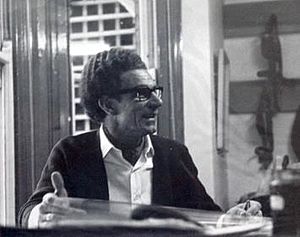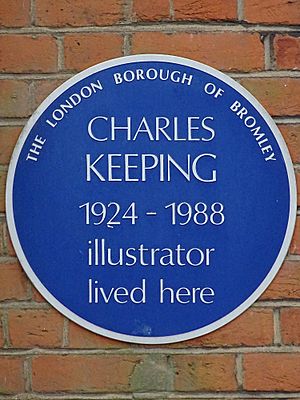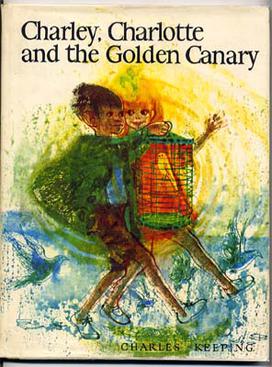Charles Keeping facts for kids
Quick facts for kids
Charles Keeping
|
|
|---|---|

Charles Keeping
|
|
| Born | 22 September 1924 Lambeth, London, England |
| Died | 16 May 1988 (aged 63) London, England |
| Occupation | Illustrator, writer, lithographer |
| Period | 1952–1988 |
| Genre | Children's literature |
| Notable works |
|
| Notable awards | Kate Greenaway Medal 1967, 1981 |
| Spouse | Renate Meyer |
Charles William James Keeping (born September 22, 1924 – died May 16, 1988) was an English illustrator and author of children's books. He was also a lithographer, which means he made art using a special printing method.
Charles Keeping became well-known for his drawings in Rosemary Sutcliff's historical novels for kids. He also created more than twenty picture books of his own. A big project he worked on was illustrating all the books by famous author Charles Dickens for the Folio Society.
Keeping won the important Kate Greenaway Medal twice. This award is for the best children's book illustration of the year. He won for his own story Charley, Charlotte and the Golden Canary (1967). He won again for a new edition (1981) of Alfred Noyes's poem "The Highwayman". His edition of The Highwayman was even voted one of the top ten winning works in the Medal's 50-year history. He also illustrated The God Beneath the Sea, which won the 1970 Carnegie Medal for children's literature. For his great work as a children's illustrator, Keeping was a runner-up for the Hans Christian Andersen Award in 1974.
His special prints, called lithographs, were shown in art exhibits around the world. You can find his prints in many art collections, including the famous Victoria and Albert Museum in London.
Contents
Growing Up in London
Charles Keeping was born and grew up in Lambeth, London. He lived in a busy city area with street markets and working horses. These sights and sounds inspired his art throughout his life. Charles and his older sister, Grace, loved to draw and make up stories. They used old newspaper posters their father brought home. Their father delivered newspapers and was also a boxer named Charlie Clarke. Charles described his childhood as "comfortable working class."
He went to the Frank Bryant School for Boys in Kennington, North London. He left school at 14, which was the youngest age allowed then. Two of his aunts paid for him to take an art course by mail. He worked at a book printing company and then an engineering company that made war supplies. He also worked as a gasman for a while. In 1942, when he turned 18, he joined the Royal Navy. He worked as a wireless operator for four years during World War II.
After the war, in 1946, Charles had a difficult time. He received help and fully recovered. This experience may have influenced how he drew Grendel, the monster from Beowulf, with a touch of understanding.
He wanted to study art at the Regent Street Polytechnic. At first, he didn't get a grant, so he read gas meters during the day. He took art classes in the evenings. Finally, he got his grant and studied art full-time from 1949 to 1952. He learned about illustration and lithography. One day in 1949, while working as a model for art students, he met Renate Meyer. She was a fellow student who had moved from Germany. They got married in 1952 and had four children.
His Art Career Begins
Early Work
After finishing art school, Keeping started working for himself. For four years, he drew a comic strip for a newspaper called the Daily Herald. But he didn't like being told exactly what to draw. He also drew cartoons for other newspapers and magazines like Punch. His first book job was drawing cartoons for a funny health book in 1953. He also did some advertising work and illustrated school textbooks.
Children's Books
In 1956, Charles Keeping started working with an agent who helped artists find jobs. This led him to Mabel George, an editor of children's books at Oxford University Press. She asked him to illustrate The Silver Branch, a historical novel by Rosemary Sutcliff. He wasn't very excited about the ancient Roman topic. But he tried new things, like drawing across two pages and in the margins. Soon, he was illustrating more books for Sutcliff and other authors. This started a long partnership with Oxford University Press. Charles Keeping, along with another artist named Victor Ambrus, created a new, exciting style for children's historical books.
The God Beneath the Sea (1970), which Keeping illustrated, won the Carnegie Medal. This book was a retelling of Greek myths by Leon Garfield and Edward Blishen.
In the late 1960s, printing technology got better. This allowed Keeping and other illustrators to use more colors in their work. In 1966, he made his first full-color picture books, Black Dolly and Sean and the Carthorse. Both books were about horses that worked hard and were not treated well. He then created Charley, Charlotte and the Golden Canary. This was a modern fairy tale about two children who live on the same street. They are separated when one family moves to a new apartment building. A pet canary helps them find each other again. This book showed how the London of Keeping's childhood was slowly changing. He often returned to this idea in his art. The colorful drawings in the book were lively and used bright colors, sponge textures, and wax resist. This book won Keeping his first Greenaway Medal.
Keeping made 15 full-color picture books for Oxford University Press and several for other publishers. Joseph's Yard (1969) and Through the Window (1970) were two of his best. They were also made into short films for the BBC's "Storyline" program. Through the Window shows many of Keeping's art styles and ideas. It tells the story through the eyes of a small boy watching the street from his bedroom window. The pictures are full of bright evening light, movement, and even seem to make sounds. Other picture books include Richard (1973), about a police horse's day. Wasteground Circus (1975) shows the magical effect a circus has on two young boys. Willie's Fire Engine (1980) is a dreamlike story about a boy in Edinburgh who dreams of being a firefighter.
In the 1980s, Oxford University Press created a new type of book for Keeping. These were black and white picture books for older children. Keeping made four books in this style:
- The Highwayman (1981): This illustrated Alfred Noyes's 1906 poem with detailed, sometimes scary, pictures. It won him his second Greenaway Medal.
- Beowulf (1982): This was an adaptation of the old Anglo-Saxon epic poem by Kevin Crossley-Holland. Keeping's drawings showed some sympathy for the monster, which was different from the story's text.
- The Wedding Ghost (1985): An original story by Leon Garfield.
- The Lady of Shalott (1986): This illustrated Alfred, Lord Tennyson's 1833/1842 Arthurian poem.
All these books used beautiful line and wash drawings. Keeping continued to make color picture books sometimes. These included Railway Passage (1974), Sammy Streetsinger (1984), and his last book, Adam and Paradise Island. This final book, published after he passed away in 1989, was another story about how London's landscape was changing.
Illustrating Classic Books
In 1964, Keeping illustrated his first book for the Folio Society, Wuthering Heights by Emily Brontë. He didn't really like the book, so he drew the characters in a special, expressive style. He was supposed to do twelve illustrations but delivered twenty-two, letting the publisher choose the best ones. He also illustrated All Quiet on the Western Front (1966) in a similar way. For the same publisher, he illustrated Ghost Stories of M. R. James (1973), The Castle of Otranto (1976), and Les Misérables (1976).
Starting in 1978 with The Pickwick Papers, Keeping began a huge project. He was asked to illustrate all the books by Charles Dickens for the Folio Society. Because he knew so much about the old industrial London, he was perfect for the job. He drew two books a year until he finished the whole series with Martin Chuzzlewit in 1988.
He also worked for another publisher, Heron Books, illustrating books by authors like Wilkie Collins, Joseph Conrad, and H. G. Wells.
Other Works and Teaching
In 1975, Keeping created a very personal book called Cockney Ding Dong. It was a large book with 190 pages, collecting and illustrating traditional songs his family used to sing together. A record of some of these songs was also released, with members of Keeping's family singing.
Keeping also taught art. From 1956 to 1963, he lectured one day a week at Regent Street Polytechnic. From 1963, he was a visiting lecturer at Croydon College of Art, teaching illustration and later lithography.
Personal Life

Charles Keeping passed away on May 16, 1988, from a brain tumor. His wife, Renate, later ran the Keeping Gallery. There, she displayed his artwork and her own for many years. She passed away in 2014.
Awards and Recognition
The Hans Christian Andersen Award is a very important award for children's book writers or illustrators. Charles Keeping was one of the top three finalists for the illustration award in 1974. He was nominated again by Britain in 1978. He also won a Golden Apple award at the Biennial of Illustration Bratislava in 1975.
He won several awards for specific books:
- 1967 Kate Greenaway Medal, for Charley, Charlotte and the Golden Canary, which he also wrote.
- 1972 Francis Williams Award for Illustration, for Tinker Tailor: Folk Song Tales.
- 1977 Francis Williams Award for Illustration, for The Wildman, written by Kevin Crossley-Holland.
- 1981 Kate Greenaway Medal, for The Highwayman, written by Alfred Noyes.
- 1987 Kurt Maschler Award, for Jack the Treacle Eater, with writer Charles Causley. This award is for books where the writing and illustrations work together perfectly.
- 1988 W H Smith Illustration Award, for Charles Keeping's Classic Tales of the Macabre.
Keeping was also a runner-up for at least three other Greenaway Medals:
- 1969, for Joseph's Yard, which he wrote himself.
- 1970, for The God Beneath the Sea, written by Edward Blishen and Leon Garfield.
- 1974, for Railway Passage, which he wrote himself. This book was "Highly Commended" for the Medal.



